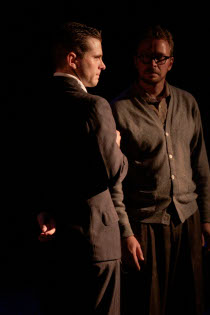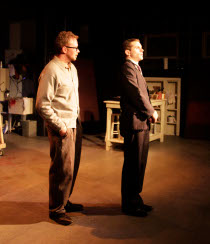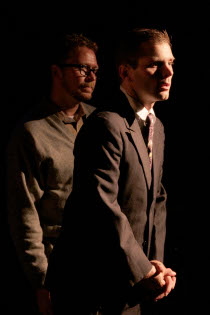 I went into Red, playwright John Logan's drama about abstract expressionist Mark Rothko and his young assistant Ken, with uncertainty about how to appreciate visual art beyond just liking pretty things I see. I left Friday's QC Theatre Workshop production with a better understanding of meaning and intent in art, while also feeling a disdain for abstract expressionism, particularly Mark Rothko's "color fields." And while I'm not certain that Logan's intent is for viewers to dislike Rothko or his paintings, I do think he wants audiences to walk away with emotion and opinions about the artist's creations - making my distaste for Rothko evidence that Logan's work is effective.
I went into Red, playwright John Logan's drama about abstract expressionist Mark Rothko and his young assistant Ken, with uncertainty about how to appreciate visual art beyond just liking pretty things I see. I left Friday's QC Theatre Workshop production with a better understanding of meaning and intent in art, while also feeling a disdain for abstract expressionism, particularly Mark Rothko's "color fields." And while I'm not certain that Logan's intent is for viewers to dislike Rothko or his paintings, I do think he wants audiences to walk away with emotion and opinions about the artist's creations - making my distaste for Rothko evidence that Logan's work is effective.
So, too, is director Tyson Danner's treatment of it. There's a high degree of artfulness in Danner's production, from set designer Lauren Nigri's re-creation of Rothko's studio - with stretchers, brushes, canvases, pigments, and other artists' implements filling the space in a way that's thorough without seeming stagey - to lighting designer Daniel D.P. Sheridan's use of pools and different types and colors of light to further explore the meaning of certain scenes. Sheridan makes an especially poignant lighting choice when Rothko (Reader employee Mike Schulz) presses Ken (Thomas Alan Taylor) for more information about the deaths of Ken's parents. He illuminates the stage with a single spotlight, allowing the light to wash across the space onto Taylor, who is almost cowering in a corner as if being questioned by police; Schulz's Rothko, for his part, stands in the shadows behind the light nearly unseen, furthering the suggestion of an interrogation.
 Even costume designer Emily Ruiz's wardrobe choices add to the poignancy, whether the clothes are covered in various amounts of paint (particularly in the play's final scene) or pristine (as when Ken makes his first appearance in a suit and tie). The picture that Danner and his behind-the-scenes team paint in Red is just as exquisite, meaningful, and balanced as any of the great artist's works.
Even costume designer Emily Ruiz's wardrobe choices add to the poignancy, whether the clothes are covered in various amounts of paint (particularly in the play's final scene) or pristine (as when Ken makes his first appearance in a suit and tie). The picture that Danner and his behind-the-scenes team paint in Red is just as exquisite, meaningful, and balanced as any of the great artist's works.
What's also exhilarating about the play is how one's view of Rothko shifts throughout the piece. Initially, I found it easy to agree with Rothko's views on art, and hung onto every one of Schulz's words. However, as Ken helped Rothko complete the Seagram murals commissioned for the Four Seasons restaurant, I began to sympathize more and more with Ken, bristled at Rothko's coldness, and recoiled from the volatile painter's frequent angry outbursts. And then, my feelings shifted to pity as I recognized the emotional pain that drove Rothko to his egotism, using it as a form of self-protection while projecting his own insecurities onto his works. Of course, all this is what I felt while watching the play, and that's the beauty of Logan's writing. Just as individuals can find different meanings in a single painting, one can walk away from Red with a perspective that's entirely different from anyone else's.
 Schulz takes on Rothko not only in his words, but in his body, walking with his head and shoulders hunched a little forward, as if being pushed from behind. The rhythm and inflections in his speech, too, seem specifically designed, with their matter-of-fact tones and lack of humor even when Rothko says rather funny lines. Meanwhile, when Rothko blows up at the suggestion that his painting needs "red," Schulz creates a palpable sense of tension and fear the more he yells, and when Rothko and Ken argue about the meaning of "red" - spewing names, objects, and feelings they associate with the color - their face-off swells to an undeniably intense stalemate, with each refusing to cave to the other's optimistic or pessimistic perspective.
Schulz takes on Rothko not only in his words, but in his body, walking with his head and shoulders hunched a little forward, as if being pushed from behind. The rhythm and inflections in his speech, too, seem specifically designed, with their matter-of-fact tones and lack of humor even when Rothko says rather funny lines. Meanwhile, when Rothko blows up at the suggestion that his painting needs "red," Schulz creates a palpable sense of tension and fear the more he yells, and when Rothko and Ken argue about the meaning of "red" - spewing names, objects, and feelings they associate with the color - their face-off swells to an undeniably intense stalemate, with each refusing to cave to the other's optimistic or pessimistic perspective.
While Schulz's Rothko seems the demon here, Taylor's Ken is the audience's sympathetic connection with the story. Ken is both eager and lost, overzealous and uncertain, as he faces the potential wrath of Rothko, and there's also a swagger to Taylor's portrayal that's reminiscent of a cool rebel from the 1950s. When recounting the deaths of his parents, though, the way the actor slumps against the wall, and the way he hesitates before finishing his sentences, clinches the emotional deal, making him a pitiable victim, even though Ken's role as such doesn't last.
As I feel I now have a better understanding of art in any form - be it a painting or, as here, a play - I am changed by having seen the QC Theatre Workshop's Red. And with that in mind, I can say that Danner's production is the most poignant, the most thought-provoking, and likely the most enduring theatre piece I've seen not only this year, but over the past few years.
Red runs at the QC Theatre Workshop (1730 Wilkes Avenue, Davenport) through September 8, and more information and tickets are available by visiting REDQC.com.










